Restricted Earth Fault (REF) relay is used as a primary protection alongside differential relays for safeguarding transformers from ground faults in both the high-voltage (HV) and low-voltage (LV) windings.
Each HV and LV winding has its own REF relay. This relay isn't able to detect phase-to-phase faults or three-phase faults (without touching the ground) because its protection boundary is from the CT on one side (primary/HV) to the CT connected to the neutral on the primary/HV side of the primary/HV winding.
For the secondary/LV winding, the protection boundary is from the secondary/LV side CT to the CT connected to the secondary/LV neutral.
The REF relay can be used to protect both Y-Y and Y-Delta transformers. In the case of a Y-Delta transformer, the neutral earthing resistor (NER) is connected to the secondary/LV winding to provide a neutral connection for return current and transformer connection.
Figure 1 illustrates the operation of the REF relay. When a ground fault occurs in either the primary/HV or secondary/LV winding, no current flows through one of the CTs (input to the REF Relay), resulting in residual current entering the REF relay, exceeding the pickup current setting. The relay then sends a signal to the Master Trip relay, which subsequently sends a tripping signal to both breakers, the primary/HV, and the secondary/LV. There's no tripping delay as the REF relay acts as the primary protection for the transformer alongside the Differential relay.










.jpeg)
.jpeg)


